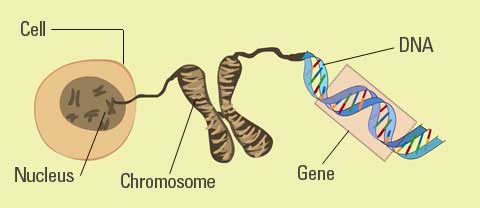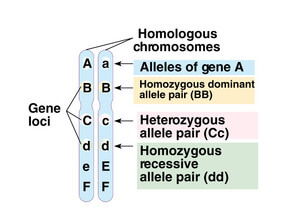What is a gene
Gene is a short section or segment of DNA. DNA is a double-stranded molecule that contains a sequence of bases; Adenine (A), Cytosine (C), Thymine (T), and Guanine (G). So, we can say that a gene is a specific sequence of bases and a unit of genetic material (DNA) that can code for protein synthesis as well as for the synthesis of ribosomal RNA, transfer RNA, etc. Genes are able to replicate and can also undergo crossing over and mutation. So, it is the functional unit of DNA or chromosome.

Only a part of the DNA molecule or strand corresponds to a single gene. Genes are located one after another as small segments of DNA in a chromosome. So, it can be said that genes are made of DNA. There are over 20000 genes in chromosomes of a human cell. They make proteins which make cells and cells make the body. A gene can vary in size. For example, in humans, some genes are made of a few hundred DNA bases, whereas, some consists of over 2 million bases.
The term genetics was introduced by William Bateson in 1905. Later, Wilhelm Johannes coined the term gene in 1909.
How do genes work?
Each gene is a sequence of specific bases so it contains specific information (a code) required to build specific proteins and thus to perform specific functions. For example, they contain the instructions for the features of a person such as eye colour, hair colour, skin colour, body height, etc.
Based on the instructions provided by the genes, the cells in our body make molecules called proteins. So, it is not the gene that works, rather, it is the protein that carries out the different functions such as making eye pigment, powering muscles, fighting invading bacteria or germs.
Similarly, the genes that contain instruction for keratin are used by cells to form keratin protein. Keratin can link together to make hairs, fingernails of the human body. So, different cells use different genes to make the body and make it perform different functions such as digestion, respiration, producing energy, growth and development, and more. So, we can say that genes are the basic physical and functional unit of inheritance as they carry the information from parents to offspring that is needed to specify traits or features. Furthermore, not all genes make proteins, some genes make RNAs that perform some other functions.
What are alleles?
A gene always exists or present in pairs just like a pair of homologous chromosomes. We can say that there are two different or alternate forms of a gene, which control the same character or feature or trait, are called alleles. In humans, the alleles of a gene always exist in a pair; one on each chromosome of a pair of homologous chromosomes and on the same location on the chromosome (humans have 23 pairs of chromosomes). The location of a gene on a chromosome where a gene is present is called the locus of that gene.

Both alleles control the same trait or feature but different forms, e.g. a gene which controls hair colour may have two alleles one for controlling brown hair colour and other for controlling black hair colour. Similarly, a gene for eye colour can have one version or allele with instructions for blue eyes and other version or allele with instructions for brown eyes. So, the final colour of the child’s eyes depends on the alleles and the interactions between alleles he or she gets from her parents.
So, there are two copies of a gene in a person. Each parent father or mother passes one copy of genes to their offspring. So, the child gets two copies (alleles) of genes, one from the mother and one from father. This is the reason, a child shows some features of his father and some features of his mother. Most of the genes are same in humans, but around less than 1% are slightly different among people. Besides this, the alleles have a small difference in their sequences of bases on DNA. These small differences are responsible for a person’s unique physical features and mental abilities.
If the alleles of the gene are same the organism is called homozygous for that gene. If they are different, the organism is called heterozygous for that gene. A person’s features or traits are determined by the combination of alleles of their genes.
What are genes made of?
Gene is a short section or segment of DNA which itself is made of millions of chemicals called nitrogenous bases. These bases are of four types; Adenine (A), Cytosine (C), Thymine (T), and Guanine (G). As the gene is a section of DNA, so each gene is made of a specific sequence of these four bases. Each base is a component of a nucleotide, which is a building block of DNA. So, we can say that genes are made of four types of nucleotides A, T, G and C. Different genes have a different combination of nucleotides. The nucleotides of one strand are connected to the nucleotides of opposite strand by hydrogen bonds, whereas, the nucleotides of a single strand are bonded with each other through phosphodiester bonds.
Different combination of bases of different nucleotides give a person different features, for example, a person with a combination of ATCGAT may have brown eyes and a person with ATCGAA may have blue eyes. A human cell has around 20000 genes and 3,000,000,000 bases. The total number of genes and bases in a cell of an organism is called genome of an organism.
History of genes:
It was the Mendel who first discovered the concept of the inheritance of traits from parents to offspring, however, he failed to describe it or find out the role of genes.
Later, Wilhelm Johannsen coined the term ‘gene’ to represent the units of inheritance of Mendel. However, he was not able to describe the chemical structure of it. Later, in 1953, James Watson and Francis Crick defined the chemical structure of DNA that is a gene.
Structure of Gene:
A gene is a short segment of DNA strand (a chain made of nucleotides). So, the entire DNA is a chain of genes or we can say that genes are units of DNA strands. The genes may vary in size based on the size of proteins for which they code.
There are three important parts or segments in the structure of a gene. The first region is the promoter, the second region is structural and the third or last region is the terminator.

There are some regions on DNA or gene that contain certain sequences that provide the signal to enzymes about the start point of a gene from where enzymes are supposed to start transcription. These sequences which promote transcription are called promoter sequences and the region containing theses sequences is called Promoter region. For example, in eukaryotes, the sequence in the promoter region is called TATA box as it is made of TATAAA base sequences.
Structural region is the region of the gene that contains the actual code that forms mRNA or we can say that is the part of a gene that is transcripted to form mRNA.
The terminator region is the region where the gene ends and contains stop codon to terminate the process of transcription. So, all regions on a DNA or gene do not act as a gene or not transcribed, however, they perform a supporting role requited to carry out transcription.
The major difference between prokaryotic and eukaryotic gene is that prokaryotic genes contain only exons, whereas, eukaryotic genes contain both exons and introns. So, prokaryotic genes are made of only exons.
Besides this, in the structural region, the exon is the part or region of a gene that codes for protein synthesis. Whereas, the intron is that part of a gene in the structural region that does not take part in protein synthesis. So exon is a coding region and intron is a non-coding region. Introns lie in between exons. They are removed from the newly formed mRNA through a process called splicing. Once introns are removed the exons join each other to form a protein-coding sequence that goes to ribosomes for protein synthesis. So, exons are the parts of the coding region of a gene that remain in mRNA after splicing. Introns are spliced off during RNA processing.
Characteristics of Genes:
- They are functional units of inheritance, variations, mutation and evolution. They determine the physical, mental and physiological features of a person and other organisms. They transfer these features form parents to their offspring.
- They are located in the chromosomes in the form of small segments of DNA.
- A gene occupies a fixed position in a DNA or chromosome. This position is known as a locus.
- The genes are arranged in a linear order one after another as beads on a string.
- They contain code or information for the synthesis of proteins, enzymes and RNAs that are needed to perform various functions in the body.
- They can make a duplicate copy of themselves through a process called replication.
- A single gene generally has two different forms called alleles.
Functions of Genes:
- Genes enable parents to pass their features to their offspring. They carry the information related to traits or features of a person and when they are passed from one generation to another the information is also transferred.
- They control or determine the phenotype of the offspring including structural and functional features.
- They control reproduction through their replication.
- They may undergo mutations and cause polymorphism and variations in humans or a species. These mutations also cause metabolic disorders and inborn errors of metabolism.
- They are also associated with the aging process.
- They regulate the transcription of mRNA and thus control the amount of protein to be synthesized. They control the functions of DNA and RNA.
- They code for various types of RNAs other than mRNA such as rRNA and tRNA.
- They can switch on or off specific genes based on the requirements of an organism.
- They carry out cellular differentiation during development.
